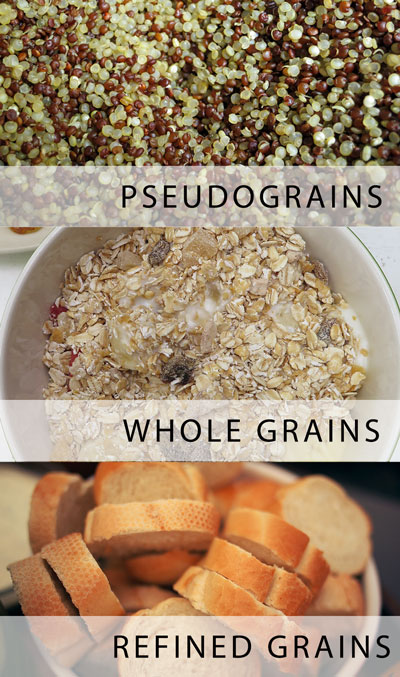Have questions? Get answers here.
We believe that not all grains are created equal. Their health effects can be quite varied and research suggests that certain grains are better than others.
To reduce confusion, we have selected three levels of classification for grains.

Pseudograins
Pseudograins resemble grains, but are not biological members of the same group i.e., amaranth, quinoa and buckwheat.
We see these as having two major benefits. Firstly, unlike processed grains, they are easier to digest and have better nutritional properties (protein, amino acids, B vitamins and iron). Secondly, they have less impact on the blood stream, which helps to stabilise both our energy and body weight.
For these reasons we allow more of these grains in the challenge than others.
Whole grains
The term whole grain refers to a variety of grains, which are still in their natural form.
Whole grains can have many health benefits, however, due to an unregulated market, their food labelling can be highly misleading and the quality very poor. Large companies have moved into this market, selling products like ‘Whole Grain’ Fruit Loops and ‘Whole Grain’ Coco Pops and completely changed the way this type of grain is represented.
A true whole grain consists of three edible parts (Reference 1):
In the challenge, you will see whole grains listed as things like oats, wheat, barley, spelt, rye, and certain forms of rice. Other less common examples can include Bulgur, Farro, Millet, Kamut and Teff.
Refined grains
Refined grains are the third level we document in our guidelines. These have had the bran and germ removed, leaving just the endosperm (2). The high-carbohydrate endosperm contains lots of starch and very little protein. This processing is popular because it significantly improves the shelf life of the product, which means more profits for the corporations making it.
The dangers
Refined grains are high in carbohydrate and can be digested and absorbed very quickly, leading to rapid spikes in blood sugar and subsequent food cravings. Over time, continual exposure to refined grains can create insulin resistance and open the door for weight gain, obesity and numerous metabolic diseases, such as type 2 diabetes and heart disease (3).
In the challenge, you will see refined grains listed as things like white bread, white rice, white flour, etc.
References:
1) Slavin J.(2003) Why whole grains are protective: biological mechanisms. Proc Nutr Soc. 2003 Feb; 62(1): 129-34
2) Steffen L, Jacobs D, Stevens J, Shahar E, Carithers T, & Folsom A. (2003)
Associations of whole-grain, refined-grain, and fruit and vegetable consumption with risks of all-cause mortality and incident coronary artery disease and ischemic stroke: the Atherosclerosis Risk in Communities (ARIC) Study. Am. J. Clin. Nutr., September, vol. 78 no. 3; 383-390
3) Yu D, Shu Xo, Li H, Xiang, Y, Yang G, Gao Y, Zheng W, & Zhang X. (2013)
Dietary carbohydrates, refined grains, glycemic load and risk of coronary heart disease in Chinese adults. Am J Epidemiol. 2013 Nov 15;178.